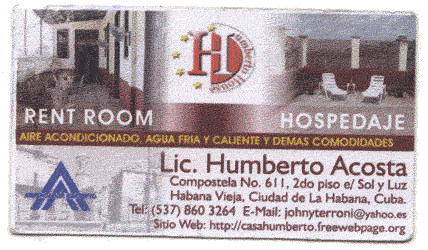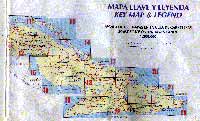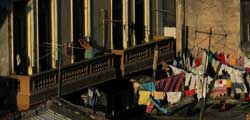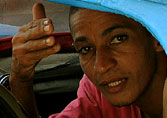Part 1 - Arrival in Havana
We had to catch an early flight. This meant being up before 5 am. I don’t think Jay slept at all. Packing had been tricky. Every single item had to count. Weight and bulk were both potentially a big problem. We even wore shorts to the airport. After all, who needs long pants in the tropics? On the plane we both grabbed blankets, window seats, and some well-needed sleep.
After our drowsy disenmbarkation, and a painless immigration, we and our embarrassingly large packs managed to sail right through customs – I hadn’t even realized we’d passed it. Ahh, those kayak packs. We were really travelling to an unknown land with sea kayaks on our backs. We had ordered the “backpack” option with both of our brand new yellow Folbot Coopers. You can’t imagine the disappointment when we saw the pack and the straps they’d given us. It’d be more comfortable dragging the 35 lb bag by your tongue. We decided to return them to Folbot, when we got back from our expedition. Instead, we had gone around Toronto searching for a proper backpack that might fit the boat. We took a look at all the kayak parts, and picked what we thought was the largest: the padded cockpit coaming, and we dragged it with us all over Toronto.
The SealLine Pro Pack, 115 L of dry bag, with pretty good shoulder straps and waist belt, adjustable, removable, and anchored to the bag in sensible places. We bought them and both attempted to pack the boats into them, but the top just wouldn’t really shut. The top is supposed to roll down for a dry seal, but we couldn't even get one fold. "Almost" can be close enough: we wanted these bags. They just made sense: although bulky, they double reasonably well for dry bag storage when packing the boat. I also thought the PVC-coated Dacron material could be handy for boat repairs in the event of a major tear in the hull.
To make them work, we bought a few meters of additional webbing and adjustors, and managed to persuade the bag to be secure for cargo transport. Fully loaded with kayak and accessories, the total weight of the bag was around 45 lb, which isn’t bad once it’s on your back. I must say you’d have to want to be pretty cruel to your back and shoulders if you actually wanted to walk more than a few miles with one of these, but we certainly managed without any real problems.
Packing the kayaks into the Pro Packs is a bit of an art form, honed and developed over time. The art can be appreciated when you have nothing sticking into your lower back while it’s mounted on you and you’re sweating and cursing down some crowded street.
You can fit quite a bit more gear in the Pro Packs the way we were using them, but we decided to bring another backpack, also on the shoulders but carried on the front. Jay also brought a guitar (ask him if he'll do it again), whose case he would pad with his sleeping bag and carry in his hand. We were quite a sight, and it seemed miraculous to me that no one at Customs had wondered what was in the bags. On the other hand, maybe if we’d had official problems with the kayaks right at the beginning of the trip, we might have approached el Ministerio del Interior, and the permissions they need to give for various things, in an entirely different way than the way we did.
We had tried to arrange a place to stay using e-mail. Rumour had it that it might be required, at Immigration, to show proof of having made reservations at some hotel for at least the first two nights in Cuba. It was for that reason that we’d set things up with “Casa Humberto”, found through a website directory of similar places (there are lots of them).
So, leaving Customs, I was expecting to find someone waiting for us with a sign in the arrivals area. I’ve never had that experience before. A sign with just my name on it. But, alas, no one. In fact, there wasn’t even a lot of hassles from taxi drivers. Just a few more or less polite offers, each relenting after only one refusal. We waited to see if our ride would show, and to wait for a fellow passenger who'd wanted to split a cab with us but hadn't been very lucky with Customs. We'd met him and his girlfriend around the baggage carousel. When he finally emerged, we all split a cab, who caught us for $35. (We only paid $10 to return to the airport, using a private car, when we left Havana at the end of our trip.) In the absence of any other ideas, we had decided to head straight there from the airport, figuring there must have been some mix-up about the dates or something.

On arrival we were welcomed and apologized to. Humberto wasn’t around, but there was a very apologetic middle-aged man named Roberto explaining that the car would not start that morning. He showed us our room and then took us up to the rooftop terrace to have a look around at all the Havana Vieja rooftops.
His English was remarkably good and we took the opportunity to find out a bit about how some thing worked, and about him. It turned out Roberto was trained as a medical doctor. Ten years he studied medicine in university, after which he spent two years doing his service to the country as a doctor in the mountains in the eastern part of Cuba (el Oriente). His wife was also a doctor. But instead of practicing, the two of them started a business baking and selling cakes. She bakes ‘em, and he sells and delivers ‘em. He says he made a pittance as a doctor: I believe he said he was paid $20 a month by the state, and worked very long hours. Now, he said, he only practices medicine with a few private patients. Otherwise he lives a stress-free existence doing the cake thing with his wife, and also helping out at Humberto’s casa particular every once in a while.
He was the one who gave us the idea that there was some fabulous and huge river in el Oriente that starts in the mountains and finishes in the sea. Our basic idea for how we wanted to begin paddling here was to find just such a river, pack everything into the boats, get in, follow it to the ocean, explore some coast, and finally end up on some sweet sanded beach enjoying the glory and planning the next segment.
To that end, the next day we finally got ourselves a map of Cuba. Unfortunately, it was far from being a set of nautical charts: it was the “Road Guide” from the Tourism Board of Cuba, the country divided into 23 small maps. Gas stations and other highway service areas were clearly marked. Topography was not marked at all, and there were only three types of land: forest, swamp/mangrove, and the white clear areas which are everything else.
 |  |
We started poring over this atlas, trying to locate this river, and trying to somehow coax out of its scanty lines an image of what the paddling would be like along different sections of coast, or down one of the many rivers.
It was near impossible to glean much from these maps. The only other data we had was that offered by the Lonely Planet guidebook, and it just didn’t seem to have organized itself for our expedition. There was no information on typical sea conditions, or regarding potential protection from land or reefs. It didn’t tell us whether sections of coast were amenable to landings or not. And there seemed to be huge sections of the country that weren’t mentioned at all. For example, we couldn’t figure out whether anyone lived on any of the hundreds of cayos that surround Cuba, especially on the north side.
We were unsure what it meant to have these kayaks in Cuba. We were a little afraid of discovery by the government, since we’d heard that historically they can have issue with people moving around their country unmonitored. That fear had no face and no certainty. Just a vague idea of what communism means with respect to personal freedom. We were also afraid of being discovered by brigands who might see the boats as being expensive and desirable. These boats are, in some ways, ideal for the kind of subterfugal exit a hopeful soul might attempt. Hey, it’s only 90 miles to Florida. With favourable currents and winds, you could do that in a sea kayak in one stupidly long day.
So, at first, we hardly mentioned the kayaks in conversation. But this paranoia was a mistake: people not knowing what we were doing worked, for the most part, to our detriment. In fact, as time passed and we became more and more open about our intentions, it became easier and easier to gather invaluable paddling information from the people we would meet. And we had little to worry about, probably. Seeing our bags, I think most people would assume that we were carrying scuba gear. Certainly no one would ever guess that they contained boats. I don’t think they would even be considered to be a viable method for going to Florida. I think you have to be familiar with sea kayaks, and especially folding ones, to really understand how ideal they are for sea conditions. To look at them you wouldn’t necessarily guess it. So, how would people know? I never saw one other sea kayak the whole time we were in Cuba. And knowing how hard it is to run off with one, I’d say that a folding kayak is the last item to worry about in terms of thievery when backpacking.
But what about the forces that be in the government, like the national police task force for anti-spy homeland security? Surely if it was discovered we had commando kayaks, all our movements would be reported to authorities? These communists are always ready to rat out their mothers for state recognition, right? Ha! What bullshit American propaganda! I mean, many profess love for Castro, but that doesn’t mean that most of the people in the country aren’t at least a little complicit in trying to evade the strictness of the laws. There is always the chance for undercovers, I guess, or surprise appearances from annoying petty bureaucrats, but anything in our initial concerns beyond some common sensical prudence were really very silly. There’s a convenient double-standard in Cuba which mostly favours foreigners, and so for the most part just about everyone in the country, state and complicit populous alike, are on our side.
In Havana, we entrusted a few selected Cuban acquaintances with our “secret”. We attempted to convey our vague plans, much to everyone’s confusion. We wanted to find a river, but it was important that it wasn’t thought that we were seeking a whitewater experience! We wanted to paddle some coastline, but we didn’t want to be stuck in an area where there were only resorts. We wanted a balance of staying in casas particulares, occasionally perhaps staying in fishermen villages, and maybe once or twice sleeping on the beach under our mosquito nets. No one outside of a given area seems to know anything about any other area, but everyone is eager to recommend places they’ve heard of as being beautiful and perfect for us.
Jay and I were both of the opinion that we should just pick any place more or less randomly, as at least anything was something, and one thing is the same as another in the absence of information. So, having thoroughly confused ourselves as to the name and location of the river Roberto had recommended, we still liked the idea of heading all the way across the country, to el Oriente. The map seemed to show all kinds of interesting bays and cayos over there. No one we met in Havana seemed to ever have been out east, let alone observed the rivers, except Roberto of course, and for some reason we never saw him around the casa again.
After much map-poring, we started to think that either the Rio Cauto or the Rio Toa might work for our purposes, and either one seemed to potentially be the one Roberto had talked about. We were able to find someone able to confirm for us that the river Cauto is the longest river in Cuba, and then further investigation revealed that we could get pretty close to it by train.





1 Comments:
What an excellent little adventure!
I live in the Bahamas and hopefully I
will one day do a kayaking trip in Cuba...been there 3 times and I love that "outlaw" feeling.
Post a Comment
<< Home